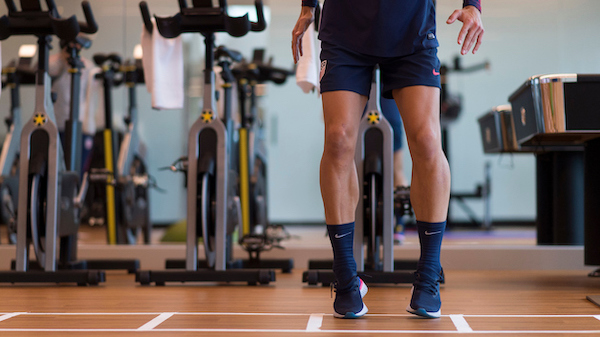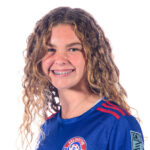Indoor Workouts Youth Soccer Players Can Do Anywhere

Children aged 6 and older need at least an hour of physical activity every day according to the Mayo Clinic (and common sense).
During the warmer months, it’s easy for your soccer kids to get that with games and practices. But even with more indoor facilities and programs like futsal, keeping up the pace is a challenge. Whether your soccer player is older and serious about their game, or just starting out but can’t get enough of the game, keeping active while working with a ball will benefit their game for the next season and beyond.
Read on to learn how to keep your child’s soccer conditioning all year with these tips.
Indoor Soccer Activities Kids Can Do Anywhere
Just because the soccer field is icy doesn’t mean that your soccer player can’t work on his or her soccer skills.
Thankfully there are plenty of things to do inside at home to keep your child’s soccer conditioning and improve their technical skills. You can do these in your basement or living room – you don’t need a ton of space.
The name of the game is repetition, repetition, repetition. Every touch on the ball for a young player strengthens their comfort with the ball. Many very basic things can make a huge difference, while increasing the speed of repetition will do wonders for their fitness.
Here are some of the best soccer drills you can do for indoor fitness this winter that involve a lot of repetition and only need a small space. They each have many variations, but these will cover the basics and are easy for soccer parents who haven’t played or coached the game themselves to follow along and support. If you’re worried about broken lamps, try the lower bounce futsal ball instead of a regular soccer ball. The futsal ball also works great if you can get outside on a tennis or basketball court between snowstorms.
Cone Dribbling
All you need is a yard or two of space, 3-5 cones (flat discs work too, but cones force the ball to go around, not over), and a soccer ball. Set up the cones in a line or triangle 1 foot apart.
Get your soccer kid to move the ball between or around the cones in specific patterns using all parts of their feet. Keep a list, time them, make it a challenge. But above all, keep it fun. There is no real right or wrong pattern to use, it’s the activity, control and speed that you’re going for. It can only help their feel for the ball and keeps their heart rate up. (And their heads out of their instagram).
Push-Pull
These two versions of the same general exercise pinpoint the muscles in the foot which can greatly improve a player’s ability to control the ball on the field or futsal court. No cones or discs needed, just a soccer ball.
Have your child set his or her foot on the ball and move it from toe to heel and back to the toe, releasing the ball slightly with each move. For added effort and a bit more realistic soccer skill, have them hop slightly on the “standing” foot with each move. It will be slow at first, but as they get the rhythm, it will get better. Be sure to use both feet, and even spend more time with the “weaker foot”.
The goal is to do it as quickly as possible without losing the ball.
Help your child set a goal – how about 100 reps on each foot in under a minute?
Getting good? Try different directions, like side to side. Try different size balls, or even a lacrosse or tennis ball! There are dozens of variations that only take a ball and yard of space.
Toe Taps
Soccer players of any age can work on toe taps. Even the youngest players can improve their speed and balance as they work on this skill.
Start with one foot on the ball. Move that foot back to the ground while you raise your other foot to tap the top of the soccer ball. Continue tapping the ball with alternating toes. It becomes a hopping movement as they get good. But be careful not to put their weight on the ball, or a blooper reel and ER visit could follow if the living room coffee table is nearby.
You start slowly and then try to speed up. Once they’re good standing in place see if they can move the ball slightly in other directions with each touch. Forward, sideways, back all improve ball skill and add to agility.
Pretty soon, your soccer players will be getting a great cardio workout as they improve the speed at which they can move their feet.
Cardio Circuit Training
Keep your kids primed for their youth soccer games by running cardio circuit training sessions at home. Kids love the challenge and variety of circuit training.
Set a timer and do 30-60 seconds of each exercise and repeat. You may want to lengthen the total circuit depending on the age and fitness levels of your soccer players. Just make sure to remind them to warm up!
Some great cardio circuit training moves include the following:
- High knees
- Butt kicks
- Jumping jacks
- Burpees
- Alternating foot hops
There are hundreds of variations for soccer circuits you could try. It’s a great way to get their heart rate up during the off-season. Make it challenging by increasing reps and speed. Keep track on a whiteboard or app and even join in if you’re looking to work off some of the holidays yourself. What better motivator for your future soccer star than to compete against soccer mom or dad to show off their youth advantage!
Final Thoughts
We hope these ideas have inspired you with ideas for getting kids active outside of soccer season.
Remember, all the conditioning, agility and speed work your soccer player does during the off months will pay off when soccer season hits.
For more soccer health and fitness advice check out these talking points for discussing nutrition and health with soccer teens.
And don’t forget mental training! Watch these great soccer movies to inspire and improve soccer IQ.
SOCCERWIRE MARKETPLACE
- The St James FC Boys Travel Tryouts
- OFFICIAL BAYERN MUNICH SUMMER CAMPS U.S.
- JOIN THE ALLIANCE!
- OFFICIAL FC BARCELONA CAMPS U.S.
- The Cup San Diego - Hosted by Legends FC
- Players Wanted - Undergraduate or Post-graduate
- Head Coach - South Region at The St. James FC
- Travel Coach - North Region at The St. James FC
- Program Manager - Chantilly at The St. James FC
- Girls Director of Player Development: South Region











